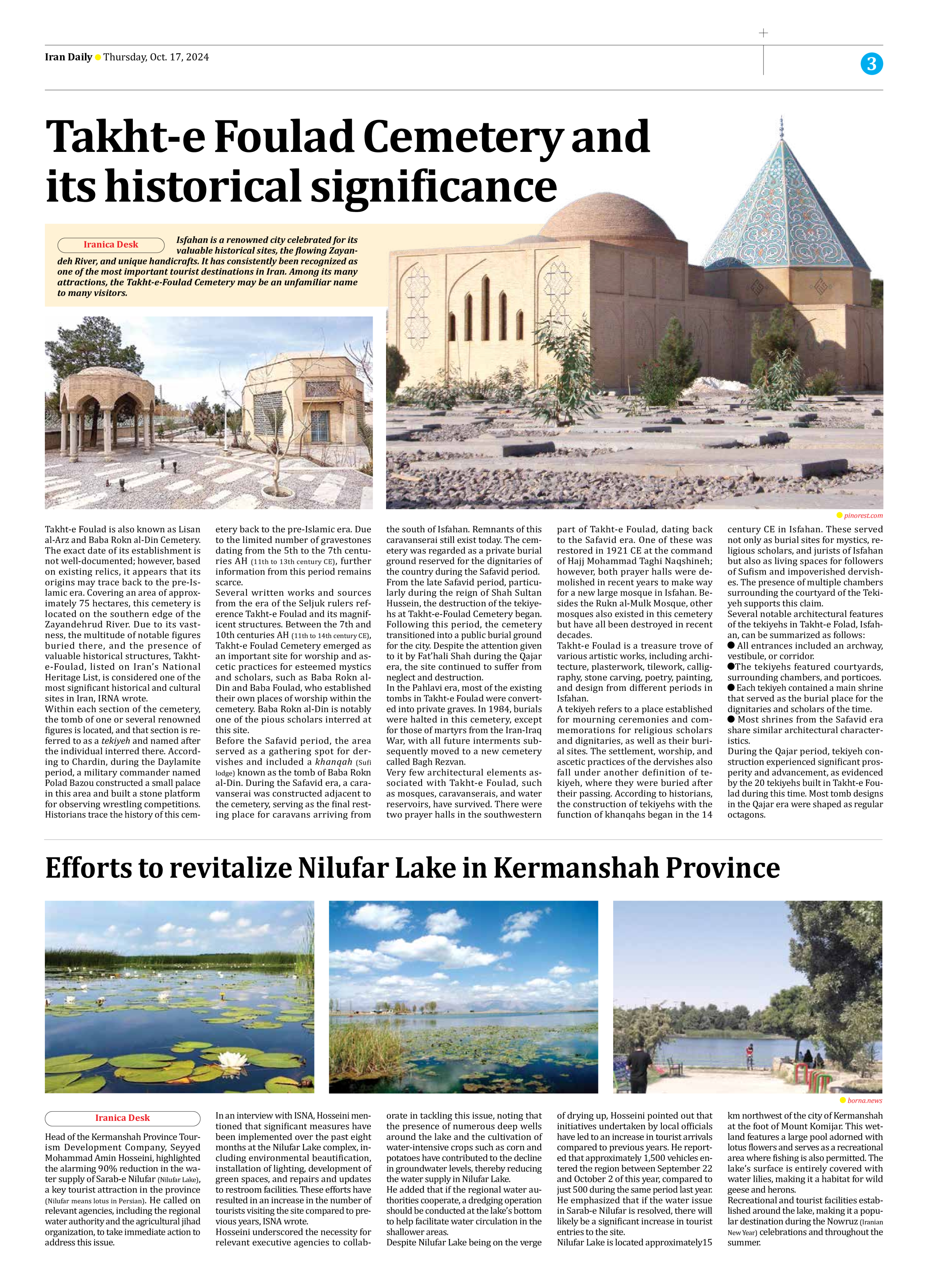
Takht-e Foulad Cemetery and its historical significance
Isfahan is a renowned city celebrated for its valuable historical sites, the flowing Zayandeh River, and unique handicrafts. It has consistently been recognized as one of the most important tourist destinations in Iran. Among its many attractions, the Takht-e-Foulad Cemetery may be an unfamiliar name to many visitors.
Takht-e Foulad is also known as Lisan al-Arz and Baba Rokn al-Din Cemetery. The exact date of its establishment is not well-documented; however, based on existing relics, it appears that its origins may trace back to the pre-Islamic era. Covering an area of approximately 75 hectares, this cemetery is located on the southern edge of the Zayandehrud River. Due to its vastness, the multitude of notable figures buried there, and the presence of valuable historical structures, Takht-e-Foulad, listed on Iran’s National Heritage List, is considered one of the most significant historical and cultural sites in Iran, IRNA wrote.
Within each section of the cemetery, the tomb of one or several renowned figures is located, and that section is referred to as a tekiyeh and named after the individual interred there. According to Chardin, during the Daylamite period, a military commander named Polad Bazou constructed a small palace in this area and built a stone platform for observing wrestling competitions. Historians trace the history of this cemetery back to the pre-Islamic era. Due to the limited number of gravestones dating from the 5th to the 7th centuries AH (11th to 13th century CE), further information from this period remains scarce.
Several written works and sources from the era of the Seljuk rulers reference Takht-e Foulad and its magnificent structures. Between the 7th and 10th centuries AH (11th to 14th century CE), Takht-e Foulad Cemetery emerged as an important site for worship and ascetic practices for esteemed mystics and scholars, such as Baba Rokn al-Din and Baba Foulad, who established their own places of worship within the cemetery. Baba Rokn al-Din is notably one of the pious scholars interred at this site.
Before the Safavid period, the area served as a gathering spot for dervishes and included a khanqah (Sufi lodge) known as the tomb of Baba Rokn al-Din. During the Safavid era, a caravanserai was constructed adjacent to the cemetery, serving as the final resting place for caravans arriving from the south of Isfahan. Remnants of this caravanserai still exist today. The cemetery was regarded as a private burial ground reserved for the dignitaries of the country during the Safavid period.
From the late Safavid period, particularly during the reign of Shah Sultan Hussein, the destruction of the tekiyehs at Takht-e-Foulad Cemetery began. Following this period, the cemetery transitioned into a public burial ground for the city. Despite the attention given to it by Fat’hali Shah during the Qajar era, the site continued to suffer from neglect and destruction.
In the Pahlavi era, most of the existing tombs in Takht-e Foulad were converted into private graves. In 1984, burials were halted in this cemetery, except for those of martyrs from the Iran-Iraq War, with all future interments subsequently moved to a new cemetery called Bagh Rezvan.
Very few architectural elements associated with Takht-e Foulad, such as mosques, caravanserais, and water reservoirs, have survived. There were two prayer halls in the southwestern part of Takht-e Foulad, dating back to the Safavid era. One of these was restored in 1921 CE at the command of Hajj Mohammad Taghi Naqshineh; however, both prayer halls were demolished in recent years to make way for a new large mosque in Isfahan. Besides the Rukn al-Mulk Mosque, other mosques also existed in this cemetery but have all been destroyed in recent decades.
Takht-e Foulad is a treasure trove of various artistic works, including architecture, plasterwork, tilework, calligraphy, stone carving, poetry, painting, and design from different periods in Isfahan.
A tekiyeh refers to a place established for mourning ceremonies and commemorations for religious scholars and dignitaries, as well as their burial sites. The settlement, worship, and ascetic practices of the dervishes also fall under another definition of tekiyeh, where they were buried after their passing. According to historians, the construction of tekiyehs with the function of khanqahs began in the 14 century CE in Isfahan. These served not only as burial sites for mystics, religious scholars, and jurists of Isfahan but also as living spaces for followers of Sufism and impoverished dervishes. The presence of multiple chambers surrounding the courtyard of the Tekiyeh supports this claim.
Several notable architectural features of the tekiyehs in Takht-e Folad, Isfahan, can be summarized as follows:
All entrances included an archway, vestibule, or corridor.
The tekiyehs featured courtyards, surrounding chambers, and porticoes.
Each tekiyeh contained a main shrine that served as the burial place for the dignitaries and scholars of the time.
Most shrines from the Safavid era share similar architectural characteristics.
During the Qajar period, tekiyeh construction experienced significant prosperity and advancement, as evidenced by the 20 tekiyehs built in Takht-e Foulad during this time. Most tomb designs in the Qajar era were shaped as regular octagons.







